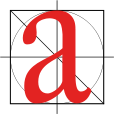- Measure (typography)
-
Measure (or sometimes "The Measure") in typography refers to the width of a block or column of text from the left margin to the right margin. Punctuation should preferably hang outside the measure. It is relative to each design, but can be used as a unit of measurement within that design to create unity and harmony.
The measure of a text influences legibility. Long lines are hard to read, short lines are more easily read. 45–75 characters per line are regarded as the ideal range for the measure. For multiple column setups, 40–50 characters are often preferred. 66 is sometimes considered ideal for one column setups. Generally, if the measure is wide, the leading of a text should be increased—if the measure is short, it is can safely be decreased. Reverse text, i.e. white text on black also requires more leading.[1][2]
The measure or the length of a legible line is the length of the alphabet (Caps, Lowercase and Numerals) of a typeface of a size being used.
References
Typography terminology Page 
Paragraph Character Typeface anatomyCounter · Diacritics · Dingbat · Glyph · Initial · Kerning · Letter-spacing · Ligature · Subscript and superscript · Swash · Text figuresCapitalizationVertical aspectsClassifications Punctuation Typesetting Calligraphy · ETAOIN SHRDLU · Font (Computer font) · Font catalog · Letterpress · Lorem ipsum · Movable type · Pangram · Phototypesetting · Punchcutting · Type design · Typeface · Type foundry · MicrotypographyTypographic units Digital typography Categories:
Wikimedia Foundation. 2010.
